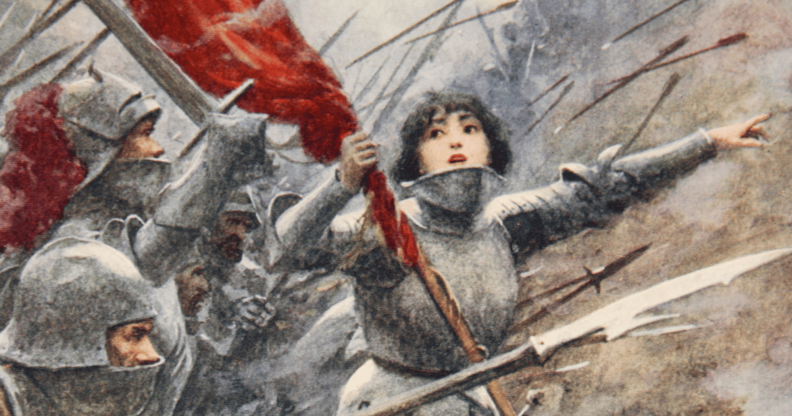Joan of Arc didn’t call herself non-binary – but gendering her isn’t that straightforward

An artist’s interpretation of Joan of Arc. (Getty)
As a new production reimagining Joan of Arc as a gender non-conforming hero sparks predictable backlash, historian Florence Scott explains why it’s impossible to define Joan’s gender through our modern lens.
A new play at Shakespeare’s Globe theatre, I, Joan, imagines Joan of Arc as a queer figure who uses they/them gender-neutral pronouns.
Though simply an artistic interpretation of Joan that offers “the possibility of another point of view”, this portrayal has been considered controversial by those alarmed by the perceived de-gendering or re-gendering of a famous historical woman as non-binary.
The historical Joan did not use ‘they/them’ pronouns – not least because she spoke Middle French. Middle French had no equivalent pronoun, though it’s interesting that singular ‘they’ did exist in English as early as the 14th century. Does that mean it’s inappropriate to explore a non-binary Joan of Arc through art? Of course not – art is interpretative.
But so is history. There is no one definitive historical truth because any way we look at history is an interpretation of the past through a modern lens that is often cloudy.
Joan is a particularly elusive and complicated historical figure. We cannot possibly access Joan’s understanding of her own gender, or how she related to the gender roles of her day. We can only look at the available source material and interpret how she expressed herself. The picture is complex.
It’s uncontroversial to say Joan of Arc deviated from what we might expect of a medieval woman.
Far from a damsel in distress, Joan was a 15th century peasant girl who had religious visions and led several successful military campaigns for the French against the English in the Hundred Years War.
Styling herself as ‘la Pucelle’ (the maiden) and wearing a cropped hairstyle and armour, Joan said God had commanded her to wear men’s clothing.
While still a teenager she was captured by the English and burned at the stake as a religious heretic, partially because of her refusal to conform to feminine dress. Joan’s complex relationship with both feminine and masculine traits makes her gender an interesting question to explore.
Joan didn’t pretend to be a man, but nor was she a typical medieval woman. The main source we have for Joan’s gender transgression is the record of her trial, which is an account written by those who condemned her to a violent death, partly because of her cross-dressing.
There is evidence of Joan herself complaining the trial record was biased against her. It doesn’t give us access to her thoughts or feelings.
We can’t assume gender roles in the Middle Ages worked like modern gender roles only stricter.
Gender, as something that is constructed, evolves over time. That means any role we ascribe to a historical figure – man, woman, or non-binary – is anachronistic, muddied by modern conceptions of gender.
In many ways medieval audiences were more comfortable with ideas we might see as transgressive. Medieval Christian theology conceived of the human soul as both genderless and sexless – male and female were only embodied states.
Medieval Christian models of feminine virtue paradoxically considered virginal women as masculine because it was believed men were better able to control their sexual urges. The idea that to be an ideal woman you had to behave like a man is inconceivable to someone with a modern understanding of gender, as is the conception of women as more influenced by their sexuality than men.
Joan called herself ‘the maiden’, but that isn’t necessarily because she wanted to emphasise her femininity – she believed her virginity was crucial to her religious calling. She wore men’s clothing, but that doesn’t mean she thought of herself as male – masculine clothing may have been a way to express her role as a military leader or her sexual unavailability.
Though it seems paradoxical, Joan likely understood her own ‘maidenhood’ as a masculine trait. Her expression of gender was bound up in medieval Christian ideas about virginity, martyrdom, and divine instruction that don’t correspond with the experiences of modern women or non-binary people. Joan was divinely inspired to lead France to victory and willing to die for her cause; this very debate over which gender box she might have ticked would be alien and inconsequential to her.
That doesn’t mean we can’t relate to Joan’s experiences of gender – just that there is a whole spectrum of ways to relate. Women have a right to be inspired by Joan as a strong woman acting in defiance of a patriarchal society, but those of us who are queer or non-binary should also be able to see ourselves reflected in her transgression of gender roles and refusal to conform.
In taking such inspiration from medieval figures, we need to be aware we are placing our modern experiences and values on someone who didn’t share them. Whether we conceive of Joan as a woman, non-binary, or even transmasculine (and I think all three are valid historical readings), we must remember that we cannot define her, we can only ever interpret her.
Florence H R Scott is a medieval historian and the author of the Ælfgif-who? newsletter.

